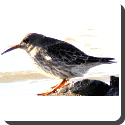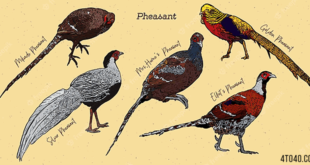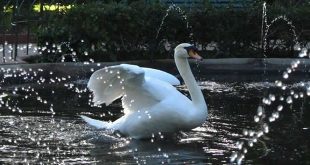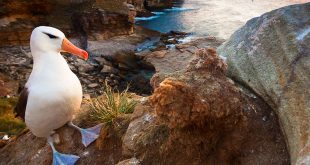 Sandpiper — The sandpipers are a large family, Scolopacidae, of waders or shorebirds. They include many species called sandpipers, as well as those called by names such as curlew and snipe. The majority of these species eat small invertebrates picked out of the mud or soil. Different lengths of bills enable different species to feed in the same habitat, particularly on the coast, without direct competition for food.
Sandpiper — The sandpipers are a large family, Scolopacidae, of waders or shorebirds. They include many species called sandpipers, as well as those called by names such as curlew and snipe. The majority of these species eat small invertebrates picked out of the mud or soil. Different lengths of bills enable different species to feed in the same habitat, particularly on the coast, without direct competition for food.
Sandpipers have long bodies and legs, and narrow wings. Most species have a narrow bill, but otherwise the form and length are quite variable. They are small to medium sized birds, measuring 12–66 cm (4.7–26 in) cm in length. The bills are sensitive, allowing the birds to feel the mud and sand as they probe for food. They generally have dull plumage, with cryptic brown, grey, or streaked patterns, although some display brighter colours during the breeding season.
Most species nest in open areas, and defend their territories with aerial displays. The nest itself is a simple scrape in the ground, in which the bird typically lays three or four eggs. The young of most species are precocial.
The sandpipers exhibit considerable range in size and appearance, the wide range of body forms reflecting a wide range of ecological niches. Sandpipers range in size from the Least Sandpiper, at as little 11 centimetres (4.3 in) and 18 grams (0.6 oz) in length, to the Eastern Curlew, at up to 66 centimetres (26 in) in length and 1 kg (2.2 lbs). Within species there is considerable variation in patterns of sexual dimorphism. Males are larger than females in Ruffs and several sandpipers, but are smaller than females in the knots, curlews, phalaropes and godwits. The sexes are similarly sized in the snipes, woodcock and tringine sandpipers. Compared to the other large family of wading birds, the plovers (Charadriidae) they tend to have smaller eye, more slender heads, and longer thinner bills. Some are quite long-legged, and most species have three forward pointing toes with a smaller hind toe (the exception is the Sanderling, which lacks a hind toe).
Sandpipers are more geared towards tactile foraging methods than the plovers, which favour more visual foraging methods, and this is reflected in the high density of tactile receptors in the tips of their bills. These receptors are housed in a slight horny swelling at the tip of the bill (except for the Surfbird and the two turnstones). Bill shape is highly variable within the family, reflecting differences in feeding ecology. Bill length relative to head length varies from three times the length of the head in the Long-billed Curlew to just under half the head length in the Tuamotu Sandpiper. Bills may be straight, slightly upcurled or strongly downcurved. Like all birds, the bills of sandpipers are capable of cranial kinesis, literally being able to move the bones of the skull (other than the obvious movement of the lower jaw) and specifically bending the upper jaw without opening the entire jaw, an act known as rhynchokinesis. It has been hypothesized this helps when probing by allowing the bill to be partly opened with less force and improving manipulation of prey items in the substrate. Rhynchokinesis is also used by sandpipers feeding on prey in water to catch and manipulate prey.
The sandpipers have a cosmopolitan distribution, occurring across most of the world’s land surfaces except for Antarctica and the driest deserts. A majority of the family breed at moderate to high latitudes in the Northern Hemisphere, in fact accounting for the most northerly breeding birds in the world. Only a few species breed in tropical regions, ten of which are snipes and woodcocks and the remaining species being the unusual Tuamotu Sandpiper, which breeds in French Polynesia (although prior the arrival of humans in the Pacific there were several other closely related species of Polynesian sandpiper).
There are broadly four feeding styles employed by the sandpipers, although many species are flexible and may use more than one style. The first is pecking with occasional probing, usually done by species in drier habitats that do not have soft soils or mud. The second, and most common, method employed is probing soft soils, muds and sands for prey. The third, used by Tringa shanks, involves running in shallow water with the bill under the water chasing fish, a method that uses sight as well as tactile senses. The final method, employed by the phalaropes and some Calidris sanpipers, involves pecking at the water for small prey.
 Kids Portal For Parents India Kids Network
Kids Portal For Parents India Kids Network




